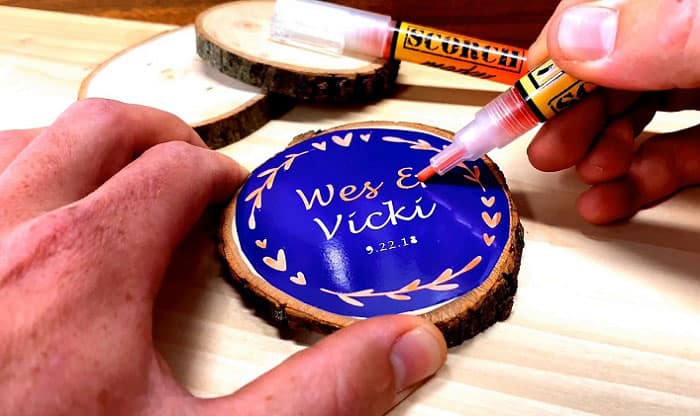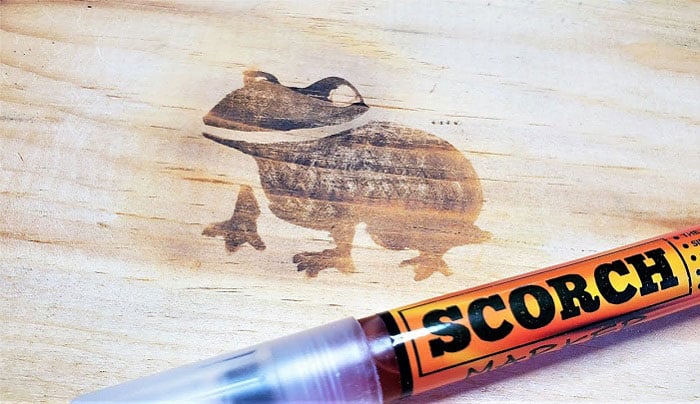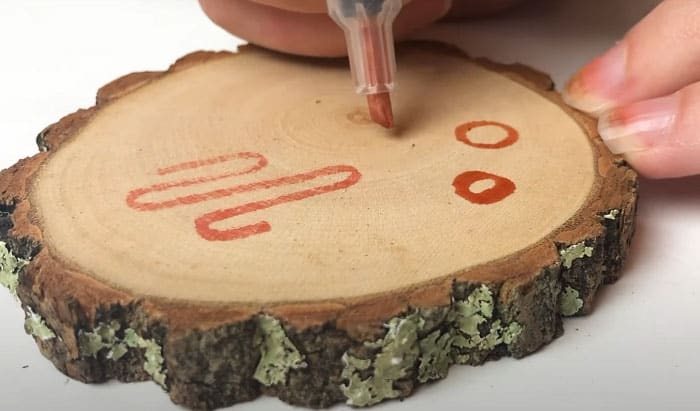Pyrography is the process of burning dried pieces of wood to create a masterpiece. It’s amazing how you can give life to a part of the tree with some crafting skills. If it’s your first time doing a project, you need to learn more about the necessary tools. You have to begin with knowing how to use a scorch marker.
A scorch marker is not only used on wood but with other materials. After you make the lines or design on the surface, you need to use the heat gun or other source of heat as long as the material allows it. Voila! The design is etched on the surface.
With the scorch marker or chemical wood-burning marker, you can do different activities, such as drawing, coloring, and tracing on the wooden surface. There’s no need for a soldering wood-burning tool as you can get a heat gun for the ink. Then, the design or image is formed on the wood. Before you get started on pyrography, let this article guide you every step of the way.
Table of Contents
Things that Work With a Scorch Marker
- Various sandpaper grits
- Heat gun (Other options are lighter, butane torch, heat-press, and so on)
- Materials: Wood, denim, canvas, or kraft paper
- Seal or finish (For wood only)
What You Can Expect From a Scorch Marker
The ‘precision tip’
The tip of a scorch marker or scorcher pen is not only designed for precision. It also has toughness to get in contact with the wood. Furthermore, it’s made of acrylic for durability.
The ‘science’ that make it crafty
A scorcher marker doesn’t look too different from the usual marker. Nonetheless, its body is filled with a special ink that reacts in the presence of heat. What happens next is the burning of a wooden surface where the formation of your design occurs. Some scorch markers have a removable foam brush at the end to provide further assistance.
Versatility
Apart from wood, a scorch marker is applicable on other materials, such as cardboard, canvas, card stock, leather, cork, gourd, denim, and paper. Besides a heat gun, other possible ways to generate heat are through butane torch, broiler, cigar lighter, heat-press, small cooking torch, direct flame, and magnifying glass plus the sunlight.
Preparing the Wood for the Scorch Marker
Aside from knowing to use a scorch marker, you have to put some effort into making the wood’s surface smooth to achieve the desired result. This is a process that will be accomplished by sanding. The process sounds simple but it’s best to know every step and detail.
Looking at the direction of the wood grain
Before sanding, drawing, or doing something on your wood, pause for a while and look closely at the direction of the wood grain. Identify the dark and light strips that run through the wooden surface. Then, you can see where the wood grain projects. Once you’ve determined it, you’ll figure out the correct direction to sand. Never go in the opposite direction as it can cause gouges and micro scratches.
Sanding is a way to eliminate small or large imperfections on the wood that might disrupt your work. This also establishes an ideal area for the soaking of the ink from the scorch marker.
Choosing the sandpaper grit
If you look for sandpaper grit, you’ll realize the varieties. The coarseness differs and each of them is represented by a number. Generally, the higher the number, the finer the grit is. These variations can accommodate different purposes. Check the following grits to pick the most suitable one for your project.
Coarse grit
This type of grit is usually from 40 to 60. Its main role is to round off rough corners and edges. You may also use it to get rid of previous paint or any finish.
Medium grit
It’s represented by 60 to 100 and is called general-purpose sandpaper.
Fine grit
This grit ranges from 100 to 220 and delivers a smooth and glossy result. Furthermore, it’s the recommended grit to use on wood that you’ll work with wood burning markers.
Some tips: The type of sandpaper grit that you need is based on the condition of your wood. The coarser grit sandpaper is necessary for raw wood that has rugged edges before you can begin the work. Then, a 220-grit is fine for the rest of the surface before using the scorch marker.
In addition, you have to know that not all wood will present itself in the same way. For example, poplar and Walnut are simple to deal with. On the contrary, the wood of purple heart and single pine may be bothersome. So, that’s why it’s best to always have various grits readily available.
Make sure the wood is clean by wiping thoroughly
After sanding, wipe the surface. It will be difficult for your scorch mark if there’s dust on the wood.
Preheating the Heat Gun
You need to be careful when using a heat gun. It can n cause serious burns and even a big fire. Hence, just use a small amount of heat in your project. With this concern, you have to preheat the heat gun. A minute or two will be sufficient.
A preheated heat gun decreases the burn time for the chemical reaction to occur. Doing it will lower the chances of mistakes and injury. By taking a minute or two, it can keep you and the wood safe.
Guide in Using a Scorch Marker
It’s best to know the outstanding burn marker before talking about the process, I’m sure you want to hear recommendations of reliable brands. Based on my experience, scorch marker Lowes, Scorch Marker Pro, and FUMILE Wood Burning Pen are great.
I bought them online and you may also check scorch marker Hobby Lobby for the necessary tools. For preparation, you have to shake the marker for up to 30 seconds or less. It’s important to prime it before using it.
It’s simply the way of mixing the liquid well with the help of a stainless steel agitator that’s inside the marker. You should always do it because missing this step will frustrate you with a blotchy burn.
You can also prime the nib by pressing down the tip to let the liquid flow into this part. At the same time, the spring-loaded valve fully saturates the nib. You may need a paper towel for dabbing any excess fluid from the scorch marker.
- Adding the liquid
You’ll appreciate how a small amount of liquid can go a long way when using a scorch marker. Using an extra amount can lead to blurred edges of your design. You can put a small amount first and see if it’s just right after burning. Anyway, there’s no hindrance to applying a second coating if it’s necessary.
The bullet tip of the scorch marker is great for drawing images and swooping lines. On the other hand, the foam brush is for calligraphy strokes and large stencils. Some people would dip paint brushes into the marker’s back. As you can see, there are endless possibilities with scorch markers.
- Activating the heat source
Once your design is ready, the magic happens with the help of a heat gun or another heat source. However, it’s best to have a heat gun as it’s easy to control. It should be working with 1,500 to 1,800 watts.
Applying more heat means darker effects. I would like to advise that you need to observe sweeping motion. Don’t let the heat stay for too long in one place. During this process, a cloud of smoke will come out so it may bother your smoke alarm if you have one nearby.
Other Materials You Can Use a Scorch Marker on
Pyrography is popular because of its flexibility. Also, scorch marker is not only exclusive for wood but you can also use it on other materials that are discussed here.
- Canvas
Canvas backpacks or bags are common nowadays. So, working with a scorch marker on canvas is also a thing. But you have to make sure that you get an artist-grade, unlined canvas.
- Denim
Don’t be surprised but this marker does wonders on denim as well! You can add fun, cool, and permanent designs to your jeans, denim jackets, and more. However, you only have to use a heat gun when working on denim as a torch can burn everything.
- Kraft paper
Using Kraft paper simply shows your care for the environment. It’s tough enough to handle the marks of pyrography. Use it and see the wonderful outcome for yourself.
Some Tips When Using a Scorch Marker
A big ‘NO’ for painting before scorching
This is the most vital thing to remember when using a scorch marker. It’s because the level of heat necessary for the chemical reaction to take place is too high for paint. If you pursue this practice, you’ll end up burning the wood.
When painting faces high heat, it will peel, crack, drip, and look unpleasant. So, you have to let the heat subside after scorching if you intend to apply paint.
More than one coat would be necessary
You may need to amplify the vibrancy of the markings left by the scorch marker. It will all depend on the wood that you use. Adding paint is another factor to consider in this case.
It’s best to take it slow and apply thin coats as you can add more layers later. As a general rule, it’s wise to have at least two coats for assurance of a satisfying result. It can also prevent uneven drying and a messy finish.
Additional sealer
A seal or finisher can protect your work from unwanted scratches and scuffs. This is a must if you intend to use the piece often. You can get Minwax Polycrylic Protect Wood Finish, Incredible Solutions Epoxy, and General Finishes High Performance Water Based Topcoat.
Scorched to Finish!
There are only a few steps on how to use a scorch marker. They’re simple and all you need to do is to take it slow. It’s advisable to do a thin coating as you can add more if it’s necessary rather than messing up when directly creating a thick layer. When doing a project, you should also think about safety measures due to the involvement of heat. Besides ways to use this markers, you also can refer to ways to use other markers such as alcohol markers or chalk markers.

Art has always been a part of my life; it influences my upbringing and later my career choice. For me, it is always a part of my parenting technique. So for whichever purpose that you come to art, you can start here with us.


